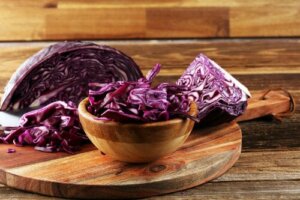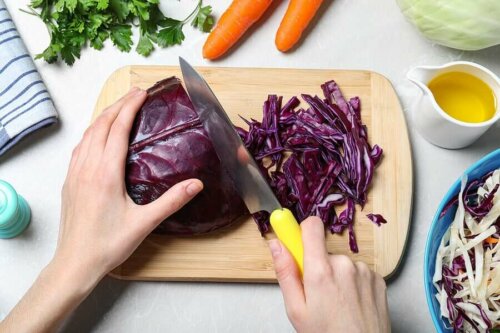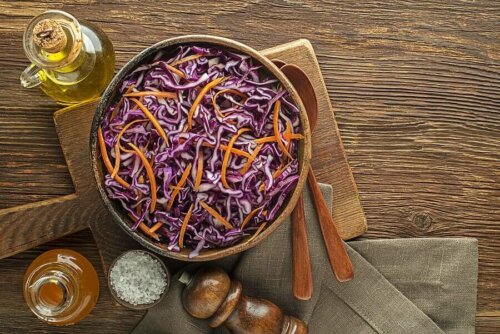11 Reasons to Add Red Cabbage to Your Regular Diet


Reviewed and approved by the physiotherapist Sofía Quintana Alonso
Red cabbage, also known as Blaukraut, is common in stores during the winter. It’s originally from the Mediterranean area and it has been cultivated since 2,500 B.C. It belongs to the Brassica group of plants, which includes other nutrient-rich vegetables such as broccoli, Brussels sprouts, and kale.
There is a difference between red and white cabbage. This difference is that the red kind has anthocyanin, a pigment from the flavonoid family. It also has powerful antioxidants. So, you’re still not including this food in your diet? So, here are 11 reasons to start eating it on a regular basis.
11 reasons to eat red cabbage
1. It’s rich in nutrients
The first reason to eat more purple cabbage is its high nutritional value. Although it’s very low in calories, it provides doses of vitamins and minerals that benefit health. Specifically, as detailed by the Food and Nutrition Information Center (USDA), each 89-gram serving provides:
- Calories: 28
- Fiber: 2 grams
- Protein: 1 gram
- Potassium: 5 percent of RDV (Recommended Daily Value)
- Thiamine: 5 percent of RDV
- Carbohydrates: 7 grams
- Vitamin K: 28 percent of RDV
- Vitamin B6: 11 percent of RDV
- And vitamin A: 6 percent of RDV
- Riboflavin: 5 percent of RDV
- Vitamin C: 56 percent of RDV
It also provides small amounts of other nutrients such as iron, calcium, magnesium, phosphorus, copper, and zinc.

2. Eating red cabbage is good for your eyes
Eating purple cabbage promotes eye health. This is because of the large amount of zeaxanthin and lutein it contains. Furthermore, as detailed in a literature review published in Archives of Biochemistry and Biophysics, these two elements are natural solar protectors that prevent UV rays from getting to your retina.
Try out these Natural Treatments for Uric Acid and Gout
3. It improves your digestion
Because of its content of dietary fiber and antioxidant compounds, red cabbage has shown favorable effects on intestinal health. In fact, a study published in the IOSR Journal of Dental and Medical Sciences found that cabbage has beneficial effects in the treatment of peptic ulcers.
4. It improves your heart health
As already mentioned, red cabbage is an important source of anthocyanins. In addition, these antioxidant substances have shown positive effects in protecting the heart.
As research published in Advances in Nutrition points out, anthocyanins lower the risk of cardiovascular disease, including hypertension, heart attack, and stroke.
5. Eating red cabbage reduces your levels of unhealthy cholesterol
Another one of the benefits of eating red cabbage is that it reduces your unhealthy cholesterol and inflammatory cytokines thanks to its antioxidant, vitamin, and mineral content.
Although more evidence is needed, a study published in the Journal of Agricultural and Food Chemistry found that anthocyanin-rich red cabbage extract (ARCE) has a protective role against induced hypercholesterolemia and cardiac and hepatic oxidative stress.
6. It strengthens your immune system
The nutrients contained in this food are useful to stimulate the immune system and, thus, increase defenses. Furthermore, according to research published in the International Journal of Molecular Sciences, this variety of cabbage helps fight inflammation and improves immune responses.
7. It keeps your skin healthy
Red cabbage juice contains high levels of antioxidants and phytochemicals, as well as vitamins C, E, and A, which help keep the skin hydrated, soft, and supple. In addition, according to information in Biomolecules & Therapeutics, its anthocyanins play a photoprotective role.
8. Red cabbage has anti-inflammatory properties
The anti-inflammatory properties of red cabbage have been widely studied and are believed to help prevent and treat several chronic diseases. For example, a test tube study, published in Molecular Nutrition & Food Research, using an artificial model of the human intestine found that this type of cabbage helps decrease intestinal inflammation by 22 to 40%.
Meanwhile, other studies suggest that its anthocyanins contribute to reducing inflammatory markers that affect chronic diseases such as obesity. It’s also been linked to benefits against inflammatory diseases such as knee arthritis.
9. It may help soothe breast engorgement
Although to date there are no fully conclusive results, and the evidence remains limited, it’s believed that the application of cabbage leaves to the breasts may help calm the symptoms of breast engorgement.
A publication in the JBI Library of Systematic Reviews suggests that cabbage leaf treatment used in women with breast engorgement may contribute to soothing the pain and hardness of swollen breasts. In addition, it may increase the duration of lactation.
10. It helps regulate your blood sugar levels
Red cabbage, and specifically its anthocyanins, have been linked to benefits in blood glucose control and diabetes prevention. A study published in the journal Nutrients concluded that dietary anthocyanins have a modulating effect on insulin resistance and, in addition, have the potential to modulate disease states such as diabetes.
11. Red cabbage helps keep your bones strong and healthy
Thanks to its Vitamin K content, the cabbage family is known for being a great help for keeping your bones strong. However, more research is needed, there’s evidence to support the role of vitamin K on bone health.

Eat more red cabbage!
As you can see, red cabbage has great health benefits. It’s nutritious and can contribute to the prevention of several health problems, in addition to bringing variety to your meals.
However, be aware that it isn’t a “superfood” or a miracle cure. It’s simply a good source of nutrients that, added to a healthy diet, helps satiate your appetite and be healthier. So, try it with some delicious boiled potatoes and a drizzle of olive oil!
All cited sources were thoroughly reviewed by our team to ensure their quality, reliability, currency, and validity. The bibliography of this article was considered reliable and of academic or scientific accuracy.
- Association of UK Dietitians. Skin health: food, fact, sheet.
- Belwal T, Nabavi SF, Nabavi SM, Habtemariam S. Dietary Anthocyanins and Insulin Resistance: When Food Becomes a Medicine. Nutrients. 2017;9(10):1111. Published 2017 Oct 12. doi:10.3390/nu9101111.
- Boi, B., KOH, S., & Gail, D. (2012). The effectiveness of cabbage leaf application (treatment) on pain and hardness in breast engorgement and its effect on the duration of breastfeeding. JBI Library of Systematic Reviews, 10(20), 1185–1213. https://doi.org/10.11124/jbisrir-2012-58.
- Food Data Central. Red, cabbage, raw. U.S Department of Agriculture. Enero 2019.
- Hammond, Billy & Wooten, Billy & Curran-Celentano, Joanne. (2001). Carotenoids in the Retina and Lens: Possible Acute and Chronic Effects on Human Visual Performance. Archives of biochemistry and biophysics. 385. 41-6. 10.1006/abbi.2000.2184.
- J.C, Enye. (2013). Evaluation of The Healing Effects of Aqueous Extracts of Musa Paradisiaca (Unripe Plantain) And Brassica Oleracea (Cabbage) on Peptic Ulcer.. IOSR Journal of Dental and Medical Sciences. 8. 40-46. 10.9790/0853-0864046.
- Joo HK, Choi S, Lee YR, et al. Anthocyanin-Rich Extract from Red Chinese Cabbage Alleviates Vascular Inflammation in Endothelial Cells and Apo E-/- Mice. Int J Mol Sci. 2018;19(3):816. Published 2018 Mar 12. doi:10.3390/ijms19030816.
- Kaulmann, A., Legay, S., Schneider, Y. J., Hoffmann, L., & Bohn, T. (2016). Inflammation related responses of intestinal cells to plum and cabbage digesta with differential carotenoid and polyphenol profiles following simulated gastrointestinal digestion. Molecular Nutrition and Food Research, 60(5), 992–1005. https://doi.org/10.1002/mnfr.201500947.
- Lee YM, Yoon Y, Yoon H, Park HM, Song S, Yeum KJ. Dietary Anthocyanins against Obesity and Inflammation. Nutrients. 2017;9(10):1089. Published 2017 Oct 1. doi:10.3390/nu9101089.
- Lyu SY, Park WB. Photoprotective Potential of Anthocyanins Isolated from Acanthopanax divaricatus Var. albeofructus Fruits against UV Irradiation in Human Dermal Fibroblast Cells. Biomol Ther (Seoul). 2012;20(2):201–206. doi:10.4062/biomolther.2012.20.2.201.
- Mc Farlane S, McFarlane G. T, et al. Review article: prebiotics in the gastrointestinal tract. Alimentary Pharmacology & Therapeutics. Septiembre 2006. 24 (5): 701-714.
- Nanashima N, Horie K, Maeda H, Tomisawa T, Kitajima M, Nakamura T. Blackcurrant Anthocyanins Increase the Levels of Collagen, Elastin, and Hyaluronic Acid in Human Skin Fibroblasts and Ovariectomized Rats. Nutrients. 2018;10(4):495. Published 2018 Apr 16. doi:10.3390/nu10040495.
- Paturel A. The ultimate arthritis dieta. The Arthritis Foundation.
- Sankhari, J. M., Thounaojam, M. C., Jadeja, R. N., Devkar, R. V., & Ramachandran, A. V. (2012). Anthocyanin-rich red cabbage (Brassica oleracea L.) extract attenuates cardiac and hepatic oxidative stress in rats fed an atherogenic diet. Journal of the Science of Food and Agriculture, 92(8), 1688–1693. https://doi.org/10.1002/jsfa.5532.
- Wallace TC. Anthocyanins in cardiovascular disease. Adv Nutr. 2011;2(1):1–7. doi:10.3945/an.110.000042.
This text is provided for informational purposes only and does not replace consultation with a professional. If in doubt, consult your specialist.








